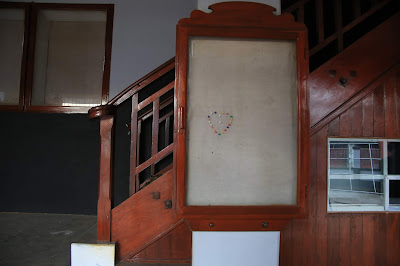If I haven't professed my disappointment at what has become of Mandalay, the storied former capitol of the Kingdom of Burma, let me do so - in brief - now.
Mandalay has been the victim of two waves of destruction in recent times. In the 1980's large portions of the city were devastated by fire, sending countless pieces of vintage architecture up in smoke. Many residents were displaced on account of it. The new structures that have replaced the old are hideous, with almost zero exceptions.
More recently Mandalay has turned into a major transit center for goods coming and going from all directions. While beneficial for the economy, Mandalay authorities seem to be unable (if not uninterested) to check the type of development which the boom has brought. That said, the going development theme across the city is to pull down architectural antiquities in favor of cheap new construction. This shortsightedness on the part of municipal authorities is pretty widespread around the world, but never have I seen it more wholesale than in Mandalay. At least not in the Southeast Asian context. As a result, Mandalay might be the least interesting city in the region from an architecture and design perspective.
If it weren't for the happy fact that Mingalar Cinemas, Myanmar's biggest movie theater operator, painstakingly cares for a few grand old picture palaces, I might completely write the place off.
First on my Mandalay cinema odyssey is the Win Lite.
Elevated view of the Win Lite Cinema
The Win Lite is the only remaining mid-20th century movie hall in Mandalay. It has managed to avoid both fire and rampant, shoddy development. When I last conducted research in the city in 2010 there was another 1950's era theater - the Ma Soe Yein Cinema - but that was recently demolished, leaving the Win Lite, which dates to 1958, as the oldest surviving movie theater in town.
A simple but elegant waiting area
The lobby area in this post-independence era movie hall is narrow compared to the spacious auditorium. It's as if - in keeping with its regimented aesthetic - loitering around the lobby area was intentionally discouraged. An in and out affair. Get you entertainment rations and be gone.
Lower level seating
Mingalar Cinema staff was kind enough to allow me photograph the interior while a film was screening. The Win Lite contains 641 seats in total
Exiting crowds
My afternoon at the Win Lite left me feeling slightly optimistic. A Valentine's Day crowd of mostly young couples packed the house to watch what looked like a well produced Myanmar romance. Capacity crowds like this are the exception rather than the norm, but theater management assured me that a steady stream of regulars keeps the Win Lite well in the black. Encouraging news in this era of movie streaming and "instatainment."











































